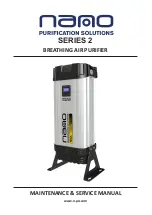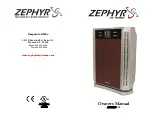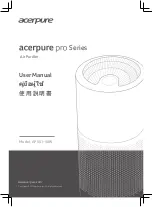
Page 7
LIQUID LINE
3/8 in. (10 mm)
TABLE 3
Ounce per 5 foot (ml per mm) adjust
from 15 foot (4.5m) line set*
*If line set is greater than 15 ft. (4.5 m) add this amount. If line set
is less than 15 feet (4.5 m) subtract this amount
SET DIAMETER
3 ounce per 5 feet (90 ml per 1524 mm)
Units are designed for line sets up to 50 feet (15.2 m).
Consult Lennox Refrigerant Piping Manual
Corp.9351−L9 and available on the Lennox DaveNet
web site for line sets over 50 feet (15.2 m).
A − Pumping Down System
CAUTION
Deep vacuum operation (operating compressor
below 0 psig) can cause internal fusite arcing
resulting in a damaged or failed compressor. This
type of damage will result in denial of warranty claim.
The system may be pumped down when leak checking the
line set and indoor coil or making repairs to the line set or
indoor coil. Attach gauge manifold then follow below:
1− Close liquid line valve.
2− Start outdoor unit.
3− Monitor suction gauge. Stop unit when 0 psig is reached.
4− Close vapor line valve.
B − Leak Testing
After the line set has been connected to the indoor and out-
door units, check the line set connections and indoor unit
for leaks.
WARNING
Fire, Explosion and Personal Safety
Hazard.
Failure to follow this warning could
result in damage, personal injury or
death.
Never use oxygen to pressurize or
purge refrigeration lines. Oxygen,
when exposed to a spark or open
flame, can cause damage by fire and
/ or an explosion, that can result in
personal injury or death.
WARNING
Danger of explosion!
When using a high pressure gas such
as dry nitrogen to pressurize a refriger-
ant or air conditioning system, use a
regulator that can control the pressure
down to 1 or 2 psig (6.9 to 13.8 kPa).
Using an Electronic Leak Detector or Halide
1 − Connect a cylinder of HCFC-22 to the center port of the
manifold gauge set.
2 − With both manifold valves closed, open the valve on the
HCFC-22 cylinder (vapor only).
3 − Open the high pressure side of the manifold to allow the
HCFC-22 into the line set and indoor unit. Weigh in a
trace amount of HCFC-22.
[A trace amount is a maxi-
mum of 2 ounces (57 g) or 3 pounds (31 kPa) pressure.]
Close the valve on the HCFC-22 cylinder and the valve
on the high pressure side of the manifold gauge set.
Disconnect the HCFC-22 cylinder.
4 − Connect a cylinder of nitrogen with a pressure regulat-
ing valve to the center port of the manifold gauge set.
5 − Connect the manifold gauge set high pressure hose to
the vapor valve service port.
(Normally, the high pres-
sure hose is connected to the liquid line port; however,
connecting it to the vapor port better protects the man-
ifold gauge set from high pressure damage.)
6 − Adjust the nitrogen pressure to 150 psig (1034 kPa).
Open the valve on the high side of the manifold gauge
set which will pressurize line set and indoor unit.
7 − After a few minutes, open a refrigerant port to ensure
the refrigerant you added is adequate to be detected.
(Amounts of refrigerant will vary with line lengths.)
Check all joints for leaks. Purge nitrogen and HCFC-22
mixture. Correct any leaks and recheck.
C − Evacuating the System
Evacuating the system of noncondensables is critical for
proper operation of the unit. Noncondensables are defined
as any gas that will not condense under temperatures and
pressures present during operation of an air conditioning
system. Noncondensables and water vapor combine with
refrigerant to produce substances that corrode copper pip-
ing and compressor parts.
NOTE − This evacuation process is adequate for a new
installation with clean and dry lines. If excessive mois-
ture is present, the evacuation process may be re-
quired more than once.
IMPORTANT
Use a thermocouple or thermistor electronic vacuum
gauge that is calibrated in microns. Use an instrument
that reads from 50 microns to at least 10,000 microns.
1 − Connect manifold gauge set to the service valve ports :
low pressure gauge to
vapor
line service valve
high pressure gauge to
liquid
line service valve
2 − Connect micron gauge.
3 − Connect the vacuum pump (with vacuum gauge) to the
center port of the manifold gauge set.
4 − Open both manifold valves and start the vacuum
pump.






























